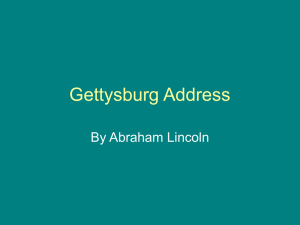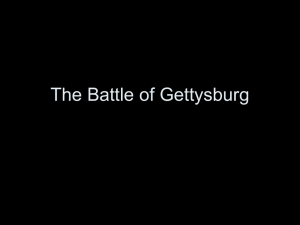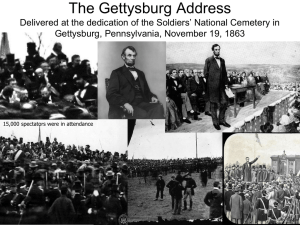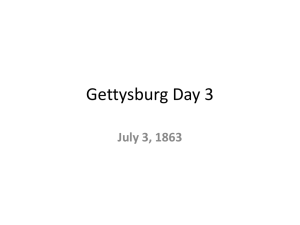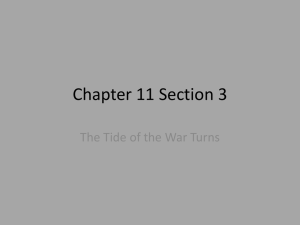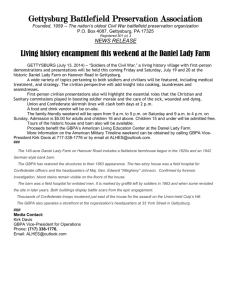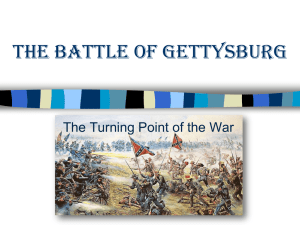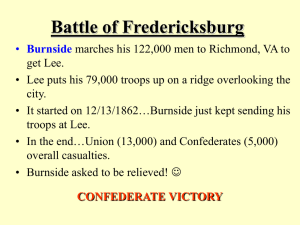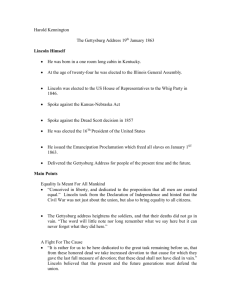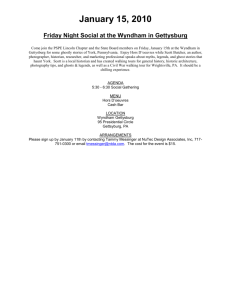The Battle of Gettysburg Lesson Plan
advertisement
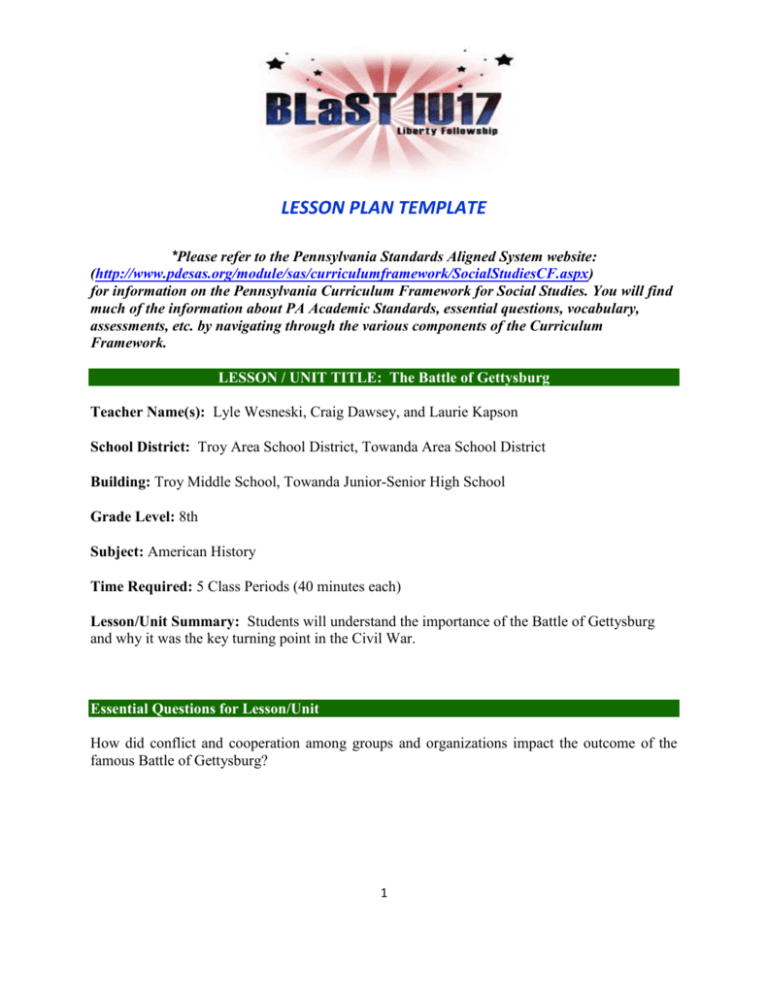
LESSON PLAN TEMPLATE *Please refer to the Pennsylvania Standards Aligned System website: (http://www.pdesas.org/module/sas/curriculumframework/SocialStudiesCF.aspx) for information on the Pennsylvania Curriculum Framework for Social Studies. You will find much of the information about PA Academic Standards, essential questions, vocabulary, assessments, etc. by navigating through the various components of the Curriculum Framework. LESSON / UNIT TITLE: The Battle of Gettysburg Teacher Name(s): Lyle Wesneski, Craig Dawsey, and Laurie Kapson School District: Troy Area School District, Towanda Area School District Building: Troy Middle School, Towanda Junior-Senior High School Grade Level: 8th Subject: American History Time Required: 5 Class Periods (40 minutes each) Lesson/Unit Summary: Students will understand the importance of the Battle of Gettysburg and why it was the key turning point in the Civil War. Essential Questions for Lesson/Unit How did conflict and cooperation among groups and organizations impact the outcome of the famous Battle of Gettysburg? 1 LESSON PLAN TEMPLATE Pennsylvania Academic Standards Addressed in Lesson/Unit (Include standards numbers and standards statements.) 8.1.8. A. 8.1.8. B. 8.1.8. C. 8.3.8. A. Compare and contrast events over time and how change influenced those events Compare and contrast a historical event using multiple points of view Produce an organized product on an assigned historical topic Examine the role groups and individuals played in the social, political, cultural, and economic development of the US. Lesson/Unit Objectives 1. 2. 3. 4. 5. Discuss and Explain “Why Gettysburg?” Describe the general landscape of the battlefield. Understand the battle tactics used on each day of the three day battle. Describe and explain the many horrors that the residents and soldiers had to endure. Understand the importance of the Gettysburg Address and its impact on our nation? Vocabulary/Key Terms for Lesson/Unit Terms Battlefield Areas/Events Cemetery Ridge Seminary Ridge Culp’s Hill Little Round Top Big Round top Devil’s Den Pickett’s Charge Gettysburg Address Canister Union Confederate Calvary Infantry Military Leaders Robert E. Lee George Meade George Pickett Joshua Lawrence Chamberlain, James Longstreet Jeb Stuart Abraham Lincoln 2 LESSON PLAN TEMPLATE Historical Background for Teachers / Research Narrative Three Days of Misery Fought during the first three days of July 1863, the Battle of Gettysburg was one of the most critical battles of the Civil War. The battle was the centerpiece of the Gettysburg Campaign, which began in the middle of June 1863, when Confederate General Robert E. Lee marched his army, the Army of Northern Virginia, out of central Virginia and north toward the Potomac River with the objective of invading Maryland and Pennsylvania. Lee had several reasons for wanting to invade the Union. His army was in need of supplies and raw materials that could not be easily obtained in the Confederacy. Lee's men had suffered greatly for want of food during the winter and spring of 1863 and he hoped that food supplies could be obtained from northern farms and warehouses, giving farmers in Virginia a chance to plant and nurture their crops without armies tramping over them. General Lee also hoped to obtain a victory on northern soil to take attention away from a dismal situation at Vicksburg, Mississippi, the last Confederate stronghold on the Mississippi River, where a Union army under General Ulysses S. Grant had surrounded the city and lay siege to it. It was also thought that a victory over the Union army on northern soil may cause Great Britain and France to recognize the Confederacy as an independent nation, and provide the growing peace movement in the North with enough reasons to press the Lincoln administration to sue for peace. All of these things could possibly end the Civil War. General Lee's hungry Confederates crossed the Potomac River, the border between Virginia and Maryland, and marched into Pennsylvania. There they found food, supplies, and many frightened civilians. The Union army, called the Army of the Potomac, cautiously followed Lee, shielding the capitol of Washington, DC from the Confederate forces and stopped at Frederick, Maryland, while the army commander, General Joe Hooker, argued with his commanders in Washington for more troops. On June 29, the Union army set out from their camps with a new commander, General George Gordon Meade, to find Lee and put a stop to his invasion. By this time, Confederate forces were spread throughout southern Pennsylvania. On June 30, a group of Confederates were marching eastward from Cashtown, Pennsylvania, when they spied Union cavalrymen just ahead near the town of Gettysburg. Under orders not to start a battle, the southerners retreated to Cashtown where they told their commander, General A.P. Hill, what they had seen. General Hill decided to send a larger part of his command toward Gettysburg the next morning to find out who those blue-clad troopers really were. He did not know they were Union cavalry from the Army of the Potomac, commanded by General John Buford. 3 LESSON PLAN TEMPLATE The Battle of Gettysburg began early on the morning of July 1, 1863, when General Buford's pickets three miles west of Gettysburg spotted the Confederate column sent by General Hill. A Union cavalry officer fired the first shot of the battle and the Confederates answered back with gun shots of their own. The cavalrymen knew they could not stop the southern infantry, so they slowly fell back toward Gettysburg until they reached the McPherson Farm. The cavalry was making one last, determined stand when Union infantry arrived just in time to throw back the Confederates. One of the first Union soldiers to fall was Major General John Fulton Reynolds, instantly killed while leading his troops into the fray. Most of the fighting on July 1 was west and north of Gettysburg. The Union troops fought valiantly against overwhelming numbers of Confederates, directed toward Gettysburg by General Lee who arrived on the battlefield at the height of the fighting. The general was slightly frustrated that his officers started a battle without his permission, for he planned to concentrate his army west of Gettysburg and fight a battle in the mountains. The heavy fighting near Gettysburg upset his plan, so Lee and watched his victorious soldiers drive the Union troops through Gettysburg to the hills south of town. It was a great victory for Lee, but not a decisive one as the Union Army did not retreat from the hills but concentrated there. General Meade arrived that night and decided to fight the battle by defending the hills and letting Lee make the next move. By the morning of July 2, the Union army had established strong positions in a giant U-shaped line from Culp's Hill to Cemetery Ridge. Satisfied with the line, General Meade decided to wait for Lee to make the next move while the remainder of the Army of the Potomac hurried to the battlefield. Early that morning, General Lee surveyed the strong Union line from his position on Seminary Ridge and realized that a weakness might be with the Union flanks. A simultaneous strike on both the right and left of Meade's position could roll up the Union line toward Cemetery Hill. Lee directed General James Longstreet to attack the Union left and General Richard S. Ewell to attack the Union right. The fighting began that afternoon at 4 o'clock and quickly spread up and down the ridges. Union cannon posted on the ridge above Devil's Den roared to life. Fighting erupted on the slopes of Little Round Top, in the Wheatfield, and at the Peach Orchard as General Longstreet's Confederates attacked these positions. At Little Round Top, Union troops threw back repeated Confederate attacks and finally saved the hill from capture after several hours of combat. Fighting swept into Devil's Den and up the line to the Peach Orchard. The situation was desperate for the Union forces who fought valiantly but were slowly forced back. The line of General Daniel Sickles, a Union corps commander, collapsed under the relentless southern attacks, Sickles himself so severely wounded that his leg required amputation. A brisk counterattack of Union reserves drove the Confederates back. Darkness 4 LESSON PLAN TEMPLATE put a grateful end to the slaughter on the Union left, but the battle was just beginning at Culp's Hill. Night had fallen by the time Confederate infantrymen under General Edward Johnson splashed across Rock Creek and began the climb up the wooded slopes of Culp's Hill. Union troops quietly waited behind earthen defenses stretched southward from the summit of the hill to a small knoll above Spangler's Spring. Union musketry and confusion in the darkness made the Confederate commander believe that he was heavily outnumbered and he stopped the attack to wait for reinforcements. Meanwhile, Confederate troops made a brilliant charge to the base of Cemetery Hill and overran Union troops stationed behind stone walls. Through the gap poured soldiers from Louisiana, called "Louisiana Tigers", who attacked Union artillery at the summit. Union reinforcements rushed to the scene and immediately attacked with rifles and bayonets, driving off the Confederates. Though General Meade's line had been heavily beaten on and almost broken, he was still able to hold his position on Cemetery Ridge. Fighting erupted on Culp's Hill early on the morning of July 3 when Union troops attacked Confederates who had taken a portion of the hill the night before. The Confederates had been reinforced by other troops and tried to drive the Union troops off of the summit of the hill, but could not get beyond the Union earthworks because of the stubborn defense they put up. After six hours of intense fighting, the Union succeeded in driving off the southerners. General Lee decided to alter his strategy. Having already ordered his cavalry chief, J.E.B. Stuart, to ride around the Union army and attack the Union supply line, Lee decided to strike the weakened Union center. He issued orders for a bombardment of the center followed by an infantry assault to be commanded by his trusted corps commander, General James Longstreet. General Longstreet's assault, better known today as "Pickett's Charge", would be Lee's last gamble for victory at Gettysburg. The Southern cannonade began at 1 o'clock and lasted for almost two hours. It was followed by the charge of 12,000 Confederates, half of them Virginia troops commanded by General George E. Pickett, and the other half commanded by Brig. General James J. Pettigrew. The Confederates succeeded in breaking the Union line at the angle near a copse of trees, but were thrown back with heavy losses. A down hearted General Lee saw the results of the charge and rode into the field to rally his soldiers. That evening, General Lee ordered his troops to prepare to retreat to the Potomac River where they would cross back into Virginia. General Meade, satisfied that his army held a superior position, waited for Lee's next move but then followed the Confederates as they marched away from Gettysburg and wound their way west to Williamsport, Maryland on the Potomac River. Swelled by heavy rains, the river could not be crossed and the Confederates were forced to build defenses in case of a Union 5 LESSON PLAN TEMPLATE attack. But Confederate engineers were able to place floating bridges across the river and the last troops of Lee's army stepped onto the Virginia side just as Meade's soldiers began to close in. The bloody Gettysburg Campaign was over. Once back in Virginia, General Lee reported to President Jefferson Davis on what happened at Gettysburg and how his soldiers had done their best to win the battle. The general never criticized any of his commanders for mistakes that may have been made, nor did he write badly of his soldiers. He knew how hard they had fought and how many of them had been left behind, including many good officers. General Meade also reported to President Lincoln and though the president was disappointed that the Union army had not destroyed Lee's army, he thanked the general for doing such a good job. Congress also thanked General Meade for the victory at Gettysburg, but there were some Union officers who were not quite so pleasant to the general, including General Sickles. General Meade was forced to defend his actions for many years to come. The cost of the battle was high- 51,000 casualties, which are all of the soldiers who were killed, wounded, captured, or missing. Every home and church in Gettysburg was a hospital, and every field and yard held a grave of a soldier, hastily dug and filled. To provide a proper burial for the Union dead, local citizens began a project for a national cemetery to be placed at Gettysburg. It was dedicated on November 19, 1863, and featured a short speech by President Lincoln. The president's Gettysburg Address is the best remembered and most revered speech of the Civil War Sources: 6 LESSON PLAN TEMPLATE Instructional Prodedures and Activities (List/describe the step-by-step sequence of procedures and learning .) Launch Activity: Anticipation Guide on Battle of Gettysburg (See attached Document.) Anticipatory Set: Visualization Exercise – Read short description of battle field scene then students will have 5 min. to illustrate what they are thinking at that point and time. When time has expired students will take part in a think/pair/ share with two other students in the class. They will be given 3 min. to complete exercise. Whole class discussion to follow. Introduce the Graphic Organizer (Fishbone Organizer): Students will complete a portion of the graphic organizer each day. At the end of the lesson the students will turn over the organizer and will answer the Lesson Essential Question with a summary of 50 words or less. Teaching Strategies: Day 1 1. Look at map of Gettysburg to make sure all students know where it is located in PA. 2. State 3 facts you know about Gettysburg using prior knowledge. 3. “Fast fact” presentation how Gettysburg was chosen as a battle sight. Why were both armies in Gettysburg on July 1, 1863? (Power Point presentation) 4. Introduce document of pay scale of the troops during Civil War era. 5. Students will begin to complete day 1 of fishbone graphic organizer. 6. Closure: Ticket out the Door. Day 2 1. Using technology, take a virtual topographical tour of Gettysburg that displays the various physical features of the surrounding area 2. Each student is given a blank map of area. Students will work in collaborative pairs to brainstorm and list important locations on the Gettysburg Battlefield. 3. Color code the blank outline map 4. Closure: On back of map students will create a “two dollar summary” of the lesson 7 LESSON PLAN TEMPLATE Day 3 1. Review/discuss the three days of the Battle of Gettysburg: a. July 1st 1863 b. July 2nd 1863 c. July 3rd 1863 2. Using a “live active map” show where the two armies were on each of the three days of the battle. Discuss various aspects that happened each day that turned the tide of battle for that particular day. 3. Show students video clips from the movie Gettysburg 4. Closure: Have students complete “Give one /Get one times 3” activity Day 4 1. Show pictures of the casualties from the battle at Gettysburg. (Google Images) 2. Describe and discuss how these injured people may have been treated by family, employers, girlfriends other soldiers. 3. Discuss what doctors did at the time to amputate limbs that were infected? 4. Incorporate video Civil War Medicine 5. Jenny Wade dialogue 6. Closure: If you are right or left handed, write a letter to your family with your opposite hand describing the injuries you sustained. Day 5 1. Listen to a copy of the Gettysburg Address. 2. Go over key words used at that time in history so kids understand what they mean. Example- “Four score” 3. Discuss how this document does not condemn the south for the vicious acts of the Civil War 4. Students will work in groups and learn one part of the address to be recited in class at a following date 5. Role play Abraham Lincoln’s Gettysburg Address 6. Closure: Create three test questions to be used as a review 8 LESSON PLAN TEMPLATE Suggested Strategies for Differentiating Instruction Independent Study Opportunity ( Challenging) Break Assignment into smaller parts Multiple Intelligence Contract Teacher Created Notes and Review Sheet for those who need them Use of pictures and media for visual spatial learners Flexible Grouping Anticipation Guide Provide Multiple Reading Opportunities Assessment of Student Learning (Formative and Summative) Formative Assessments: Student Observations; Class Discussions/Debates; Exit Tickets; Learning Logs; Fishbone Graphic Organizer; Vocabulary 4 Square; Think-Pair-Share; Give OneGet-One; Standing Conversations; “two dollar” lesson summary of battlefield locations; letter describing injuries; create 3 sample test questions to be used as a review for the Unit test. Summative Assessments: Answer lesson Essential Question in 50 words or less; Create Gettysburg Newspaper; Gettysburg Web Quest; Create a Gettysburg Collage; Role Play Gettysburg Address; Gettysburg Unit Test Materials and Resources Included Materials: Power Point presentation, Fishbone Graphic Organizer, Anticipation Guide Maps of the Battle of Gettysburg Internet resources: Google images Videos: Gettysburg, Civil War Medicine Primary source document: Gettysburg Address 9 LESSON PLAN TEMPLATE Author(s) of Unit/Lesson Plan Lyle Wesneski, Troy Area School District, Troy Middle School Craig Dawsey and Laurie Kapson, Towanda Area School District, Towanda Jr.- Sr. High School 10
